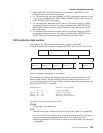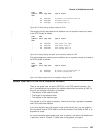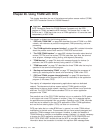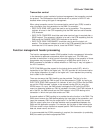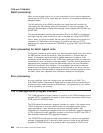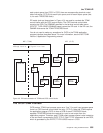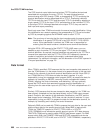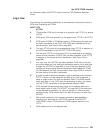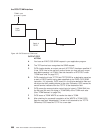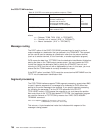Transaction control
In the transaction control method of protocol management, the transaction controls
the protocol. The SNA session should be bound with a protocol of HDX-FF with
brackets when running this type of management.
When using transaction control, the communication control byte (CCB) is used to
relay information from the transaction to the DMH. For example:
v EXEC CICS SEND LAST should be used to end a transaction. This causes an
indicator to be set in the CCB requesting that the DMH send an end-of-bracket
(EB) character.
v EXEC CICS CONVERSE should be used when terminal input is required after a
SEND request. This causes an indicator to be set in the CCB requesting that the
DMH send the CHANGE DIRECTION indicator to the device.
v EXEC CICS ISSUE DISCONNECT should be used to end the logical unit
session. This causes an indicator to be set in the CCB requesting that the DMH
terminate the LU-LU session (that is, issue the IEDHALT macro).
Function management header processing
The function management header (FMH) enables function management information
to be directed to particular components within the logical unit. The FMH also
provides a mechanism in which control information relating to the operation of those
components may be passed. FMH processing is a BIND-time option (that is, a
BIND parameter is available to indicate whether an FMH may or may not appear in
the LU-LU session).
CICS-TCAM SNA provides support for the logical device code (LDC), which is
transmitted in the FMH to the logical unit. The LDC provides for the communication
of the logical disposition of output to the logical unit. It can represent any meaning
that is useful to the installation.
There are two ways that FMH handling can be provided. The first is for the
transaction to provide the FMH as part of the data passed to TCAM, by issuing an
EXEC CICS SEND FMH command. An indicator is set in the CCB so that the DMH
can set the “FMH included” indicator in the request handler (RH) by using the
IEDRH macro. On input, the DMH should interrogate the RH (using the IEDRH
macro) to determine whether an FMH is included in the data. If the FMH indicator is
set in the RH, the DMH should set the FMH indicator in the CCB relating to the
transaction in which the input data contains an FMH.
A second method of FMH handling is to provide the entire function in the DMH. The
DMH should remove the FMH before passing the input data to the transaction, and
insert the necessary FMH into the output data. For the DMH to build the correct
FMH for output, some form of private interface must be established between the
DMH and the application program. For example, the first byte of data following the
CCB can contain unique values that request specific FMH functions such as begin
data set, erase record, and so on.
It is recommended that if FMH processing is required, the transaction (or preferably
BMS) be used to provide the appropriate FMH.
CICS with TCAM SNA
Chapter 26. Using TCAM with CICS 693



